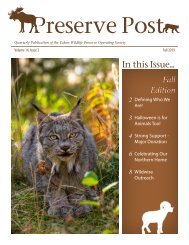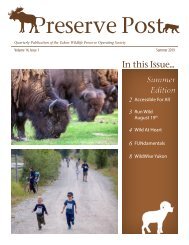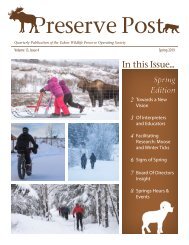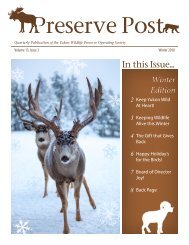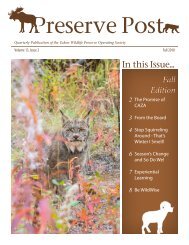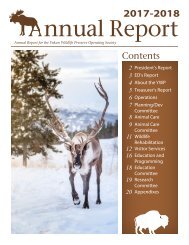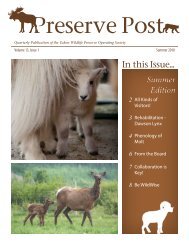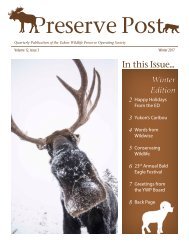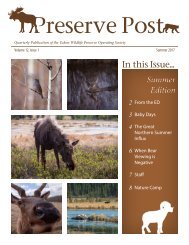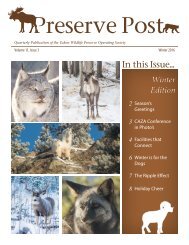Preserve Post - Fall Edition 2016
Fall is a time of great change from the colours of the landscape to the behaviour of animals. Find out more in the Fall edition of the Preserve Post!
Fall is a time of great change from the colours of the landscape to the behaviour of animals. Find out more in the Fall edition of the Preserve Post!
Create successful ePaper yourself
Turn your PDF publications into a flip-book with our unique Google optimized e-Paper software.
Quarterly Publication of the Yukon Wildlife <strong>Preserve</strong> Operating Society<br />
Volume 11, Issue 2<br />
<strong>Fall</strong> <strong>2016</strong><br />
In this Issue...<br />
2 YWP Hosts 40th<br />
Annual CAZA<br />
Conference<br />
3 Animal Update -<br />
Introducing a Silver<br />
Fox<br />
4 <strong>Fall</strong> Releases<br />
6 A WildWise <strong>Fall</strong><br />
7 Running Wild for<br />
Rehabilitation<br />
8 Backpage<br />
<strong>Fall</strong><br />
<strong>Edition</strong>
From the Executive Director...<br />
40 th Annual CAZA Conference<br />
comes to Whitehorse – next<br />
week!<br />
We are very pleased and excited to be hosting the 40th<br />
annual conference and AGM for “Canada’s Accredited<br />
Zoos and Aquariums” from September 21st thru<br />
September 24th, <strong>2016</strong> at the Kwanlin Dün Cultural<br />
Centre.<br />
or hedgehogs (and possibly others).<br />
On Saturday the 24th the animals and animal handlers<br />
will be in the Flexi-hall at the Canada Games Centre<br />
starting at 10:00am and continuing with 45 minute live<br />
animal presentations until 4:00pm. These presentations<br />
are open to the general public. All we ask is that you<br />
consider a donation to the Yukon Wildlife <strong>Preserve</strong> –<br />
Wildlife Research and Rehabilitation Centre (WRRC)<br />
so that we can continue to care for, rehabilitate and<br />
hopefully release mended animals back into the wild.<br />
Please note that families with children with special<br />
needs are invited to the Canada Games Centre for a<br />
special one-hour show from 9:00am to 10:00am!<br />
Please go to www.caza<strong>2016</strong>.ca to see all conference<br />
details and to order a conference day ticket, or an<br />
event ticket to our Ice Breaker on September 21st,<br />
Wildlife <strong>Preserve</strong> Field Trip on the 23rd and/or our<br />
Closing Banquet on Saturday the 24th.<br />
We have put together an exciting program where<br />
we are focusing on “Facilitating knowledge sharing<br />
and collective action” in an effort to provide<br />
pertinent, timely and practical knowledge and skills<br />
in communicating conservation messaging through<br />
zoo and aquarium programming – to both adults and<br />
children.<br />
In addition to offering some very interesting plenary<br />
sessions at the KDCC, we are also undertaking a<br />
hands-on live animal conservation outreach program<br />
to all Whitehorse Elementary School children on<br />
Thursday the 22nd and Friday the 23rd. These will<br />
not be your typical northern animals – species may<br />
include dwarf caimans, pythons, tortoises, tarantulas,<br />
scorpions, barn owls, parrots, lemur, sugar gliders and/<br />
2<br />
We hope you will consider joining us for some or all<br />
of our conference!<br />
Above: Whilte catching some morning rays this mountain goat<br />
struts its strong body past the photographer.<br />
Cover photos, from top to bottom: A female woodland caribou<br />
blends perfectly into the changing season; the arctic fox starts<br />
to show its winter whites; morning browse in a picture perfect<br />
fall environment.<br />
Volume 11, Issue 2
Animal Update - Silver Fox<br />
The <strong>Preserve</strong> is excited to<br />
announce a new resident! Now on<br />
display, although very difficult to<br />
spot, is a beautiful silver fox with<br />
an incredible story!<br />
If you are fortunate to catch a<br />
glimpse, it’s tough to tell how<br />
difficult his journey here has been.<br />
This silver coloured Red Fox<br />
has only three legs. He arrived at<br />
the <strong>Preserve</strong> in fall 2015 with a<br />
swollen, injured foot. On closer<br />
examination, the <strong>Preserve</strong>’s Dr.<br />
Maria Hallock and her colleague<br />
at All-Paws Veterinary Clinic,<br />
Candace Stuart found a piece of<br />
wire wrapped around the leg. The<br />
wire had been on for such a long<br />
time that it was embedded in the<br />
bone, leaving his foot numb and<br />
swollen.<br />
The paw was definitely a problem.<br />
Walking on it and then licking and<br />
chewing on it was making it even<br />
worse.<br />
Dr. Hallock<br />
and Dr. Stuart<br />
conducted a<br />
surgery to remove<br />
the wire, hoping<br />
that would be<br />
enough to restore<br />
circulation and<br />
reduce swelling.<br />
After several<br />
months of<br />
healing time<br />
with regular laser therapy,<br />
there was little improvement.<br />
The fox was continuing to<br />
damage the foot and it was<br />
clear a more drastic solution<br />
was necessary.<br />
This time, the surgery was to<br />
completely remove the leg.<br />
Amputating above the injury<br />
was going to be a recipe for<br />
further injury so the surgical<br />
team, led by Dr. Stuart<br />
planned to remove the entire leg,<br />
including the scapula.<br />
After a grueling 6 hours in surgery<br />
it was done. Major blood vessels<br />
were clamped and sewn closed<br />
and the skin from the upper leg<br />
was used to close the shoulder.<br />
He looked small without that<br />
leg. It was an ambitious surgery<br />
because although foxes and dogs<br />
are similar, they are very different<br />
species.<br />
Recovery went incredibly well.<br />
Within days after the surgery the<br />
fox was moving around on three<br />
legs with ease, even jumping up<br />
several feet onto a platform. His<br />
hair eventually grew back in and<br />
now, almost a year later, he’s out in<br />
the public eye.<br />
Over the coming months we’ll be<br />
switching our famous red fox and<br />
this new silver fox back and forth<br />
in the Red Fox exhibit. They don’t<br />
get along (and are really solitary<br />
animals).<br />
Clockwise from left: the radiograph (x-ray) shows a dark indented line across his leg where the wire was<br />
located and the swollen paw at top lect; the swollen paw was several times larger than it should have<br />
been; surgery was long but successful!<br />
<strong>Fall</strong> <strong>2016</strong><br />
3
<strong>Fall</strong> Releases<br />
Animal Care...<br />
The golden eagle has long<br />
inspired admiration through<br />
its hunting mastery. Its<br />
wings long and broad help<br />
it navigate as it hunts with<br />
precision and protects its<br />
prey againsts large thieving<br />
mammals.<br />
Radiant gold feathers are<br />
interlaced along its head<br />
and neck making it stand<br />
out from the more common<br />
bald eagle. Less social than<br />
bald eagles, the golden is<br />
usually found alone among<br />
the open country, mountains<br />
and cliffs.<br />
It is truly a joy to be able to<br />
release such an animal back<br />
into the wild.<br />
This juvenile will get a second<br />
chance at life back in its home<br />
territory of the Aishihik Lake<br />
area.<br />
The young golden eagle came<br />
to the <strong>Preserve</strong> August 8 th<br />
underweight and not flying.<br />
With a bit of time and food<br />
the eagle regained body mass.<br />
Soon it was flying effortlessly<br />
in the flight pen - it was ready<br />
for the wild. On a sunny<br />
morning in early September<br />
the eagle soared over the<br />
yellow and green treetops and<br />
out of sight into the wilds of its<br />
Yukon home.<br />
4<br />
Clockwise from top left: Ready for lift off - emerging from the crate the eagle is<br />
ready to go home; soaring over the treetops of the Aishihik Lake area the eagle<br />
looked perfectly at home; long and strong feathers lift the bird above the stunted<br />
aspens; Golden eagle profile in all its golden glory!<br />
Volume 11, Issue 2
Well Timed Recoveries<br />
This warbler was only stunned after striking our<br />
office window. It quickly sorted itself out with a<br />
45 minute rest. We watched for signs it was ready<br />
including greater alertness, shifting head, and<br />
moving from branch to branch. Sometimes a bird<br />
needs to get its bearings after hitting a window.<br />
Don`t let it`s small size fool you. The kestrel<br />
(smallest of the North American falcons) is a<br />
powerful predator. This individual struck some<br />
fencing near the Shallow Bay area.and endured<br />
some soft tissue damage. Luckily it had no<br />
fractures and the healing time was quick. With<br />
help from its finders, this colourful raptor was<br />
ready for a second chance.<br />
Another bald eagle flies high over the Mc Intyre<br />
Creek area after 3 months in rehabilitation. CBC<br />
featured the original story in June when two<br />
eaglets were found by a photographer after their<br />
nest blew down. One of the pair was euthanized<br />
due to extensive damage to its wing but the sibling,<br />
with no fractures, took the 3 months to grow<br />
into its flight feathers and out of its fluffy down<br />
plumage. It emerged large, strong, and ready for<br />
life back in the wild!<br />
<strong>Fall</strong> <strong>2016</strong><br />
This young gull was found unable to fly in Porter<br />
Creek in the spring. It needed more time to grow<br />
than the migration timeline would allow. So the<br />
gull saved a bit of engergy and got some extra<br />
help catching up with its migrating flock thanks to<br />
Air North Yukon`s Airline.<br />
5
A WildWise <strong>Fall</strong><br />
<strong>Fall</strong> brings so many changes for<br />
people and for wildlife. While we<br />
are busy stacking wood, filling our<br />
freezers and getting back to school,<br />
bears (and other wildlife) are doing<br />
similar things. The berries are<br />
ripe and the salmon are running.<br />
Grizzly and black bears need to<br />
pack the calories in to survive a<br />
long, cold winter and successfully<br />
reproduce. They will be looking for<br />
calories well into early winter.<br />
(that means<br />
they get used to<br />
the presence of<br />
humans, dogs,<br />
etc.) and even<br />
more easily food<br />
conditioned (that<br />
means they will<br />
return to a food source that they got<br />
a reward from the first time). Bears<br />
are not territorial but they<br />
will defend a resource, so<br />
a food conditioned bear is<br />
a dangerous bear.<br />
In the fall we often have<br />
bones, fish racks and<br />
smokers, hides and other<br />
things that bears may find<br />
delicious out in our yards.<br />
We may have chainsaw<br />
oil, gas cans and other<br />
petroleum products more<br />
easily accessible and<br />
bears like these things too<br />
(weird, but true!). We may have<br />
ripe fruit and berries on our trees<br />
and bushes, root vegetables ready<br />
for the taking and compost piles<br />
brewing in a very potent way.<br />
Please consider taking a look<br />
around your yard this fall and<br />
securing the things that bears and<br />
other wildlife might be attracted to.<br />
Electric fencing, locked sheds and<br />
garbage cans and timely harvesting<br />
can all help reduce negative<br />
interactions with bears and keep<br />
your neighborhood safe.<br />
We have all kinds of resources on<br />
our website that may help your<br />
community become “bear-smart”.<br />
Please visit us at wildwise.ca.<br />
As we use more and more land for<br />
cities, roads, resource development<br />
and recreation, bears are either<br />
forced into smaller areas with<br />
fewer food resources, or into<br />
areas where people live, work and<br />
play. Human-bear interactions are<br />
common in the Yukon, especially<br />
along roadways where bears<br />
take the opportunity to graze on<br />
nutrient rich grasses, and in areas<br />
where they have easy access to<br />
human food resources such as<br />
livestock, feed and garbage. Bears<br />
will eat almost anything and are<br />
easily habituated<br />
6<br />
Above: Electric fencing helps keep a black bear from killing livestock and becoming a ``problem`bear;<br />
a black bear gorges on fall ripened rose hips bushes. Facing page: Animal care assistant Julianna<br />
releases 3 red squirrels back to the wild before the Run Wild fiundraiser; A particpant makes his way<br />
past scaling goats; a few runners become distracted by an impressive male caribou.<br />
Photo Credit: Peter Mather<br />
Volume 11, Issue 2
Running Wild for Rehabilitation<br />
Run Wild <strong>2016</strong> got off to a squirrely start on the morning of<br />
Discovery Day! Three red squirrels got a head start on the 83<br />
particpants in this<br />
years 5km run/<br />
walk for wildlife<br />
rehabilitation.<br />
Particpants raised<br />
$1446 for wildlife<br />
rehabilitation. This<br />
year also saw the<br />
youngest first place<br />
finisher, Nathyn<br />
Sutton 12 years of<br />
age, place a time of<br />
24:25.<br />
There were many disctractions for<br />
particpants along the scenic figure-<br />
8 route including rutting muskox<br />
and impressive antler racks. The<br />
money raised will go directly<br />
towards the necessary food and<br />
medicine for species injured or<br />
orphaned.<br />
Look for our event next year,<br />
Discovery Day 2017 and help wild<br />
animals get back to the wild!<br />
Yukon<br />
Wildlife<br />
<strong>Preserve</strong><br />
Full-time Staff<br />
Greg Meredith, Executive Director<br />
Sheila Downey, Executive Assistant<br />
Randy Hallock, Operations Director<br />
Dr. Maria Hallock, Wildlife Curator<br />
Jake Paleczny, Director of Programming<br />
& Education<br />
Lindsay Caskenette, Manager of Visitor<br />
Services<br />
Daniel Jolkowski, Animal Care &<br />
Operations Assistant<br />
Justine Benjamin, Animal Care &<br />
Operations Assistant<br />
Logan Sands, Operations Assistant<br />
Board of Directors<br />
Alexandra de Jong Westman, President,<br />
Chair of Animal Care Committee<br />
Lacia Kinnear, 1 st Vice-President<br />
Michael Kokiw, 2 nd Vice-President<br />
Kristine Hildebrand, Treasurer<br />
Jessie Dawson, Director at Large<br />
Chris Evans, Director at Large<br />
Katelyn Friendship, Director at Large<br />
Kirk Cameron, Director at Large<br />
Brooke Rudolph, Director at Large<br />
Shireley Adamson, Director at Large<br />
Shawna Warshawski, Director at Large<br />
Ed van Randen Non-voting Member -<br />
Environment Yukon<br />
Darrell March, Non-voting Member -<br />
Environment Yukon<br />
<strong>Fall</strong> <strong>2016</strong><br />
7
Above: Some fall advice - take a moment to reflect!<br />
Meet the Exotics - CAZA Comes to Town!<br />
Canada’s Accredited Zoos and Aquariums conference<br />
is happening from Sep. 21st-24th in Whitehorse!<br />
Join CAZA organizations “Little Ray’s Reptile<br />
Zoo” and “Hands-on Exotics” for a day of liveanimal<br />
presentations at the Canada Games Centre on<br />
Saturday, Sep. 24th!<br />
Public shows start at 10am, running every 45 minutes<br />
until 4pm!<br />
Families with children with special<br />
needs are invited to a special 1<br />
hour show from 9am to 10am!<br />
Admission is by donation<br />
to Wildlife Research and<br />
Rehabilitation at the Yukon<br />
Wildlife <strong>Preserve</strong>.<br />
Writing: Lindsay Caskenette, Jake Paleczny, Greg Meredith,<br />
WildWise Yukon-Heather Ashthorn,<br />
Photos and illustrations: Lindsay Caskenette, Jake Paleczny, Tom<br />
8<br />
Patrick - Yukon News, Justine Benjamine, Peter Mather, Kieran<br />
Oudshoorn/CBC, Green Orhid Estates, Hands On Exoctics<br />
When to Visit<br />
<strong>Fall</strong> Hours<br />
10:30am to 6:00pm: Daily<br />
Guided Bus Tours at 12pm, 2pm & 4pm<br />
Walk, run, bike anytime while open. We also<br />
highly encourage skipping!<br />
Curious about the latest news? Visit facebook.<br />
com/yukonwildlife or call 456-7300.<br />
We’re on Instagram now!<br />
Share your adventures with us through Social<br />
Media and we`ll re-share our favs!<br />
Printed on 100% Recycled Paper<br />
Volume 11, Issue 2





